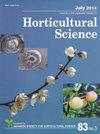A Major QTL Controlling Earliness of Fruit Maturity Linked to the Red leaf/Red flesh Trait in Apple cv. 'Maypole'
Journal of The Japanese Society for Horticultural Science
Pub Date : 2013-04-01
DOI:10.2503/JJSHS1.82.97
引用次数: 11
Abstract
Anthocyanins, which contribute red coloration to apple skin, are recognized for their antioxidant properties. Some apple cultivars also accumulate anthocyanins in fruit flesh. In this study, we analyzed the inheritance of coloration traits in fruit skin, fruit flesh, and leaves as well as their candidate gene, and searched for quantitative trait loci (QTLs) for fruit maturity linked to the red flesh trait in ‘Maypole’, using a ‘Fuji’ × ‘Maypole’ F1 population. Phenotypic segregation in the F1 population indicated that red skin, striped skin, red flesh, and red leaf traits are each controlled by separate single dominant genes and that red leaves co-segregated with red flesh. Of these, a striped skin trait derived from ‘Fuji’ corresponded to the MdMYBA genotype, known to regulate anthocyanin synthesis in fruit skin, suggesting that this genotype may be responsible for fruit skin coloring patterns. The red leaf/red flesh trait derived from ‘Maypole’ co-segregated with the MdMYB10 R6 promoter. MdMYBA and MdMYB10 were located in the same region at the bottom of linkage group (LG) 9 on the same genetic material, supporting that these genes are allelic. Analysis of the relationship between red coloration and fruit maturity revealed that fruits of red-fleshed progeny tended to mature earlier than those of white-fleshed progeny. A major QTL accounting for 35.6% of the total variance (logarithm of odds [LOD] = 8.94) was detected near the MdMYB10 locus in ‘Maypole’, indicating that the factor controlling earliness of fruit maturity is tightly linked to the red leaf/red flesh trait.一个与苹果红叶红肉性状相关的控制果实早熟的主要QTL。“五朔节花柱”
花青素使苹果皮呈红色,它的抗氧化特性是公认的。一些苹果品种也在果肉中积累花青素。本研究以‘富士’ב五月柱’F1群体为材料,分析了‘五月柱’果皮、果肉和叶片颜色性状及其候选基因的遗传特性,并寻找与果实成熟度红肉性状相关的数量性状位点(qtl)。F1群体的表型分离表明,红皮、条纹皮、红肉和红叶性状分别由单独的单显性基因控制,红叶与红肉共分离。其中,来自“富士”的条纹皮肤特征与MdMYBA基因型相对应,MdMYBA基因型调节果皮中花青素的合成,这表明该基因型可能负责果皮的颜色模式。来自“Maypole”的红叶/红肉性状与MdMYB10 R6启动子共分离。MdMYBA和MdMYB10在同一遗传物质上位于同一连锁组(LG) 9底部的同一区域,支持这两个基因是等位基因。红色与果实成熟的关系分析表明,红肉后代的果实比白肉后代的果实成熟得早。在“五月柱”MdMYB10位点附近检测到一个主QTL,占总方差的35.6%(优势对数[LOD] = 8.94),表明控制果实早熟的因子与红叶红肉性状密切相关。
本文章由计算机程序翻译,如有差异,请以英文原文为准。
求助全文
约1分钟内获得全文
求助全文
来源期刊
自引率
0.00%
发文量
0
审稿时长
>36 weeks

 求助内容:
求助内容: 应助结果提醒方式:
应助结果提醒方式:


